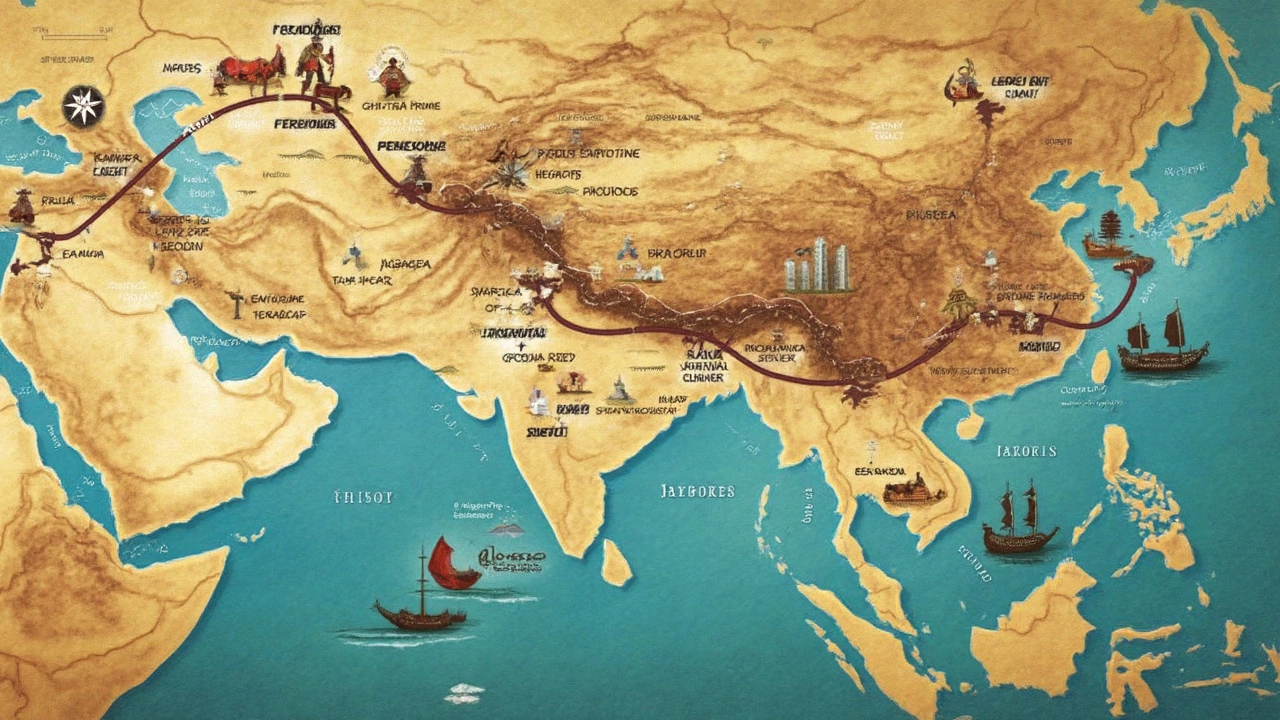
Back in the day, India was the place to be if you were serious about trade. People crossed oceans and deserts, risking pirates and bandits, just to get here. What made India such a huge magnet for merchants? Simple: stuff you couldn't get anywhere else.
Think about it—black pepper, cardamom, cinnamon, cotton, and indigo. These weren't just for flavoring food. They were status symbols. In Europe during the Middle Ages, pepper literally worked as currency. Imagine people counting out peppercorns to pay rent. That's how big a deal Indian spices were. And those textiles? Soft, vibrant, way better than the scratchy wool folks were wearing up north.
- The Spice Magnet: Why Everybody Wanted Indian Goods
- Geography, Ports, and Easy Access
- Trade Networks: Who Came and What They Took Home
- What Modern Traders Can Learn from India's Past
The Spice Magnet: Why Everybody Wanted Indian Goods
If you ever wondered why traders from places like Rome, Arabia, or Portugal kept heading back to India, it all comes down to a handful of goods that drove everyone nuts—mostly spices. Spices weren’t just about making food taste better. In medieval Europe, they were used to preserve food, mask bad tastes, and even make medicines. No surprise that black pepper, cardamom, and cinnamon were treated almost like gold.
To put it bluntly, Indian spice trade changed the world. Ships crossed dangerous seas and caravans tackled beastly deserts for a load of cloves or peppercorns. India was the only source for a bunch of these spices for centuries. Arab traders actually kept the routes secret just to control prices and supply, making the goods even more valuable back in the markets of Venice or Lisbon.
But it wasn’t just spices. Indian cotton, silk, and dyes were equally in demand. European traders would often pack their ships with silver, knowing they’d swap every ounce for things like indigo dye or fine muslin cloth in Indian ports. The profit margins? Crazy. Some records show returns up to 400% on a single trip during the 16th century.
| Indian Goods | Main Foreign Buyers | Primary Uses |
|---|---|---|
| Pepper | Europe, Middle East | Food, Medicine, Preservation |
| Cotton Textiles | Europe, Africa, Asia | Clothing, Trade barter |
| Indigo Dye | Europe, Middle East | Textile coloring |
| Cinnamon | Arab, Portuguese | Food, Perfume |
Here’s a pro tip if you’re eyeing any trade courses—study trade patterns. Knowing why Indian products had such a reputation will give you insight into how global demand works now. The paths may have changed, but the basic rules? Still the same.
Geography, Ports, and Easy Access
India’s location is like hitting the jackpot for trade courses students. Just look at a map—the country sits smack in the middle of major sea routes connecting East Asia, the Middle East, and Europe. This made it super convenient for ships to pull in, grab goods, and set sail again. Wind patterns helped, too. Traders could literally hitch a ride with the monsoon winds from the Red Sea or the Persian Gulf, and reach Indian shores with less hassle.
Ports were India’s real secret weapon. Towns like Calicut (now Kozhikode), Surat, and Mumbai (back in the day, Bombay) were buzzing with activity. Calicut was so famous that famous explorer Vasco da Gama landed there in 1498. He wasn’t just sightseeing—he and those after him set off a wave of new trade routes, all focused on India. By the 17th century, Surat was the leading port in Western India with ships from England, Holland, and Portugal lined up, all hustling to buy Indian textiles and spices. And, Southern ports like Chennai (Madras) and Kochi brought in trade from Southeast Asia and China.
Check out some mind-blowing numbers about these ports at their peak:
| Port City | Peak Century | Main Goods Traded | Known Foreign Traders |
|---|---|---|---|
| Calicut | 15th-16th | Spices, Textiles | Arabs, Portuguese, Chinese |
| Surat | 17th | Cotton, Indigo, Spices | British, Dutch, Portuguese |
| Mumbai (Bombay) | 18th | Cotton, Opium | British |
| Kochi | 16th | Pepper, Ginger | Portuguese, Dutch |
These ports weren’t just for loading and unloading. They became melting pots. Markets, warehouses, and communities for every major trading nation popped up. Traders didn’t just make deals—they exchanged business tips, shared tech, and even brought in new food and fabrics.
Makes you wonder: if you’re considering trade courses in India now, where do you think all those lessons start? Right at the ports where global commerce got its first real taste of India’s riches.

Trade Networks: Who Came and What They Took Home
India was on everyone's trade radar way before the age of planes or emails. Long before the British or Dutch showed up, the place buzzed with traders from places as far as Rome, Arabia, China, and Southeast Asia. Each of these folks wanted something different, but they all came for a piece of India’s riches.
Arab traders dominated for centuries. They pretty much ran the entire Indian Ocean trade circuit from the Red Sea to the west coast of India. They carried home spices, precious gems, and fine cotton textiles. Fun fact: the Arabic word for pepper is still filfil, sounding a lot like 'pepper' in many other languages because of this ancient trade.
Chinese merchants caught on early, too. By the first century, they shipped silk, porcelain, and tea, swapping it for India’s black pepper and textiles. These weren’t just casual exchanges. Sometimes, they’d set up shop on the Indian coast and wait until the monsoon winds made it safe to sail home—think of it as the original import-export internship.
Europeans got serious in the 15th century. The Portuguese were first, then the Dutch, French, and finally the British, all scrambling for the trade courses India naturally offered to the global market. Vasco da Gama’s arrival in Calicut in 1498 opened the door for direct sea routes, and suddenly spices like pepper, nutmeg, and cinnamon became even more valuable in Europe—sometimes, ounce for ounce, more than gold.
- Roman Empire: Took back pepper, pearls, and ivory.
- Arab Traders: Cotton, spices, and gems.
- Chinese Merchants: Indian pepper, textiles, and horses went east.
- European Powers: Mainly focused on pepper, textiles, indigo, tea, and saltpeter for gunpowder.
Here’s a quick look at what each major group took from India:
| Trader Group | Main Exports Taken from India | Main Goods Exchanged/Imported by India | Era |
|---|---|---|---|
| Romans | Pepper, Spices, Pearls, Ivory | Gold, Silver, Wine | 1st-4th century CE |
| Arabs | Textiles, Spices, Precious Stones | Dates, Horses, Silver | 7th-15th century |
| Chinese | Pepper, Textiles, Horses | Silk, Porcelain, Tea | 1st century CE onwards |
| Europeans (Portuguese, Dutch, British, French) | Pepper, Indigo, Cotton, Tea, Saltpeter | Silver, Machinery, Weapons | 16th-20th century |
These trade networks didn’t just move goods. They moved ideas, food habits, and even languages. That’s why you see chai in Russia, spicy curries in the UK, and Indian textiles inspiring European fashion. Traders took more home than just cargo—they spread India’s influence far and wide.
What Modern Traders Can Learn from India's Past
If you’re diving into trade courses, India’s old-school trading game is like a blueprint. Traders back then knew how to turn local strengths into global demand. They figured out what others wanted—spices, silk, or cotton—and milked that advantage. That’s exactly what today’s smart traders and business owners should be doing: double down on what you’re good at, and find a hungry market.
Back in 1498, Vasco da Gama hit Calicut and opened the door for direct sea trade. That single trip didn’t just change the trading map—it changed the profits, too. Fast forward, and you’ll see companies today copying the same model: cut the middlemen, know the route, and scale up. Just check the table below. It compares how Indian exports shifted during the golden age of trade and how exports look now:
| Time Period | Main Indian Exports | Major Buyers |
|---|---|---|
| 15th-17th Century | Spices, textiles, indigo, gemstones | Europe, Middle East, Southeast Asia |
| 2023 | Pharmaceuticals, refined petroleum, machinery, IT services | USA, UAE, China, European Union |
Here’s what really matters if you want to get ahead in trade today, just like the pros of the past:
- Trade courses should teach you to spot changing trends quick—because markets shift just like they did centuries ago with new trade routes or discoveries.
- Don’t rely on one market. Traders who lasted played several regions against each other. If one got strict, they just shifted focus.
- Build deep local knowledge. The best moguls understood how things worked on the ground, from port fees to local customs.
- Keep an eye out for the next big product. Who knew turmeric would end up in Western smoothies after being an Indian kitchen staple for centuries?
If you add these old tricks to your modern toolkit, you’ll be way ahead. And if you’re picking a trade course in India, go for ones that teach both classic strategies and modern skills—because the real winners blend the old and new.
